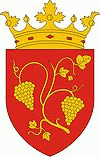Gönc
 |
Gönc has been inhabited since the Conquest of Hungary. In the Middle Ages it was royal estate and an important market town.
Between 1570 and 1647, it was the seat of the county of Abaúj county and, as a result, it developed into an ever-growing market town. Although the lands in this region were owned by Magyar landlords, Gönc itself was a crown possession. In the 13th century the court invited German craftsmen to settle at Gönc, as was the practice in many other settlements. As a result of this, the village became more and more dominated by the new settlers.
During the age of the Reformation, Gönc became a cultural centre. It was here that Gáspár Károli, the first to translate the Bible into Hungarian in 1590, served as a minister. He is commemorated by a statue standing in front of the Calvinist church. In 1687 the Protestant college of Sárospatak temporarily moved to Gönc.
After the Treaty of Trianon Hungary lost its northern parts and Gönc became close to the new border, losing its importance in trade.
Gönc was granted town status again in 2001.
Map - Gönc
Map
Country - Hungary
 |
 |
| Flag of Hungary | |
The territory of present-day Hungary has for centuries been a crossroads for various peoples, including Celts, Romans, Germanic tribes, Huns, West Slavs and the Avars. The foundation of the Hungarian state was established in the late 9th century AD with the conquest of the Carpathian Basin by Hungarian grand prince Árpád. His great-grandson Stephen I ascended the throne in 1000, converting his realm to a Christian kingdom. By the 12th century, Hungary became a regional power, reaching its cultural and political height in the 15th century. Following the Battle of Mohács in 1526, it was partially occupied by the Ottoman Empire (1541–1699). Hungary came under Habsburg rule at the turn of the 18th century, later joining with the Austrian Empire to form Austria-Hungary, a major power into the early 20th century.
Currency / Language
| ISO | Currency | Symbol | Significant figures |
|---|---|---|---|
| HUF | Hungarian forint | Ft | 2 |
| ISO | Language |
|---|---|
| HU | Hungarian language |















